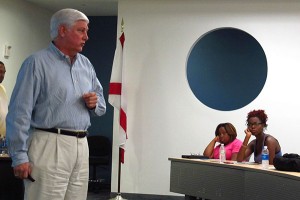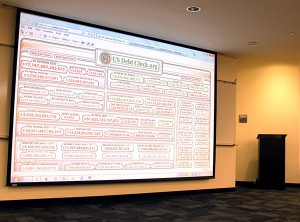How Broward College Is Cutting Student Debt

John O'Connor / StateImpact Florida
The debt management seminar taught by Kent Dunston is part of the school's efforts to reduce student loan debt.
To get a student loan at Broward College, you’ve got to sit through a two-hour financial lesson with Kent Dunston first.
At times, it’s a little like “Scared Straight!” – that 1978 documentary about setting juvenile delinquents on the right path — but for your credit score.
Dunston’s first piece of advice – figure out how much money you’re going to need.
“You’re not going to borrow more than that amount of money,” he told the students. “You’ll be offered more. You don’t need it.”
Dunston is in charge of student loan defaults for Broward College. Those are students who stop paying their loans for nine months or longer.
Colleges have long been concerned about GPAs and SAT scores.
But now they have to be concerned about default rates as well. That’s the percentage of students who stop paying their student loans.
The latest numbers are coming out today, and schools will now face punishment from the federal government if the rate is too high. Some schools could be closed.
The financial seminar is one of 13 Dunston will teach as classes start up this fall. It’s required for anyone taking out a student loan.
About 75 students watch Dunston explain their share of the ever-growing national debt clock.
It’s part history lesson – Dunston tells the students about British scholar Samuel Johnson, who wrote a seminal dictionary.
“He had to leave Oxford University in England after his first year because he did not have enough money to attend,” he says. “It’s not about your generation or his generation. It has always been difficult to find money to go to college.”
He’s also part life coach – telling the story of a young woman concerned how her $137,000 student loan debt would affect her chances of getting married.
“That can throw a lot of cold water on a relationship,” he says, “unless the guy can say ‘Well that’s OK baby, I owe $87,000 myself.”
The students laugh. Maybe a little nervously.

John O'Connor / StateImpact Florida
Broward College students listen to Kent Dunston's debt management workshop.
Bob Hovey is heading back to college to get an advanced nursing degree. He learned a tough lesson with his first student loan.
“I wish I would have had this, when I took my first loan 30 years ago,” Hovey said.
“I went to go get a house loan and that’s when it came up that I owed six thousand dollars. And that’s when I was lucky enough to have enough money to pay it off. But it will follow you. And it will find you, so there is no running from this debt.”
Broward College’s debt management course is just one part of the school’s efforts to prevent students from defaulting on their loans.
The school is also trying what seems like a simple idea – don’t let students borrow more than they need.
The problem is unsubsidized loans.
There are two common kinds of loans, subsidized and unsubsidized. The federal government pays the interest on subsidized loans until after students graduates.
But students have the pay the interest on unsubsidized loans right away – and they have a higher interest rate so the debt builds up even faster. And if students want an unsubsidized loan, they can get it.
“Students, typically, if they’ve got it available they go ahead and take those loans out,” said Bob Robbins, associate VP for student affairs.
He says the tuition at Broward College is about $2,400. Students can borrow more than twice that in subsidized loans — up to $5,500.

John O'Connor / StateImpact Florida
Kent Dunston uses the ever-growing national debt clock as an example how society has a tough time saying no to spending.
Many students used to borrow even more in unsubsidized loans, and federal law said Broward College had to accept those loans.
But not anymore.
Broward College is part of a U.S. Department of Education experiment and has gotten permission to reject all unsubsidized loans – federal or private.
So far, Robbins sees no downside.
“One of our big concerns, is what the student impact would be,” Robbins says. “And we were really, really surprised at what happened…we didn’t see many complaints. Enrollment didn’t drop – in fact it increased a little bit the first year.”
The most important change was the reduction in student debt – $12 million less in the first year alone.
And the percentage of students who default on their loans within two years of leaving school has dropped from about 10 percent to 8 percent. That’s lower than other Florida colleges of similar size.
24-year-old Ciara Hendrix is hoping to get into the nursing school. That’s why she’s at Dunston’s debt management class.
“It’s just more helpful when you learn it face to face instead of sitting there on a computer screen clicking and going through the motions,” she said. “You absorb the information better and you retain it better.”
Hendrix says she’s grateful that learning how to manage money now is part of her education.
